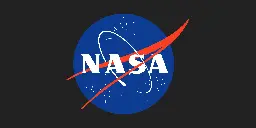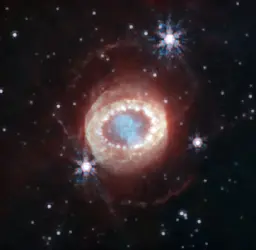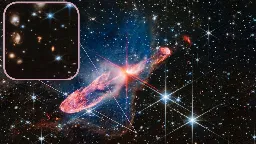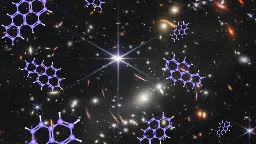
James Webb Space Telescope
- NASA’s Webb Depicts Staggering Structure in 19 Nearby Spiral Galaxiesscience.nasa.gov NASA’s Webb Depicts Staggering Structure in 19 Nearby Spiral Galaxies
It’s oh-so-easy to be absolutely mesmerized by these spiral galaxies. Follow their clearly defined arms, which are brimming with stars, to their centers, where there may be old star clusters and – sometimes – active supermassive black holes. Only NASA’s James Webb Space Telescope can deliver highly ...

- Long-wavelength NIRCam Orion mosaic in ESASky

One of the brightest nebulae in the night sky is Messier 42, the Orion Nebula, located south of Orion’s belt. At its core is the young Trapezium Cluster of stars, the most massive of which illuminate the surrounding gas and dust with their intense ultraviolet radiation fields, while protostars continue to form today in the OMC-1 molecular cloud behind.
https://www.flickr.com/photos/nasawebbtelescope/53230009083/in/album-72177720305127361/
- NASA’s Webb Snaps Supersonic Outflow of Young Star

Herbig-Haro (HH) objects are luminous regions surrounding newborn stars, formed when stellar winds or jets of gas spewing from these newborn stars form shock waves colliding with nearby gas and dust at high speeds. This image of HH 211 from NASA’s James Webb Space Telescope reveals an outflow from a Class 0 protostar, an infantile analog of our Sun when it was no more than a few tens of thousands of years old and with a mass only 8% of the present-day Sun (it will eventually grow into a star like the Sun).
- Webb Reveals New Structures Within Iconic Supernovawww.nasa.gov Webb Reveals New Structures Within Iconic Supernova - NASA
NASA’s James Webb Space Telescope has begun the study of one of the most renowned supernovae, SN 1987A (Supernova 1987A). Located 168,000 light-years away in

NASA’s James Webb Space Telescope has begun the study of one of the most renowned supernovae, SN 1987A (Supernova 1987A). Located 168,000 light-years away in the Large Magellanic Cloud, SN 1987A has been a target of intense observations at wavelengths ranging from gamma rays to radio for nearly 40 years, since its discovery in February of 1987. New observations by Webb’s NIRCam (Near-Infrared Camera) provide a crucial clue to our understanding of how a supernova develops over time to shape its remnant.
https://www.nasa.gov/feature/goddard/2023/webb-reveals-new-structures-within-iconic-supernova
- Webb Reveals Intricate Details in the Remains of a Dying Star – James Webb Space Telescope

Editor’s Note: This post highlights data from Webb science in progress, which has not yet been through the peer-review process.
NASA’s James Webb Space Telescope obtained images of the Ring Nebula, one of the best-known examples of a planetary nebula. Much like the Southern Ring Nebula, one of Webb’s first images, the Ring Nebula displays intricate structures of the final stages of a dying star. Roger Wesson from Cardiff University tells us more about this phase of a Sun-like star’s stellar lifecycle and how Webb observations have given him and his colleagues valuable insights into the formation and evolution of these objects, hinting at a key role for binary companions.
https://blogs.nasa.gov/webb/2023/08/21/webb-reveals-intricate-details-in-the-remains-of-a-dying-star/
- || Webb's Mid-Infrared-Instrument reveals asteroid belt surrounding the young star Fomalhaut. || This is the first asteroid belt ever seen outside of our solar system in infrared light. ||

This image of the dusty debris disk surrounding the young star Fomalhaut is from Webb’s Mid-Infrared Instrument (MIRI). It reveals three nested belts extending out to 14 billion miles (23 billion kilometers) from the star. The inner belts – which had never been seen before – were revealed by Webb for the first time.
Full Report- https://www.nasa.gov/feature/goddard/2023/webb-looks-for-fomalhaut-s-asteroid-belt-and-finds-much-more
- Webb Reveals Colors of Earendel, Most Distant Star Ever Detectedwww.nasa.gov Webb Reveals Colors of Earendel, Most Distant Star Ever Detected
NASA’s James Webb Space Telescope has followed up on observations by the Hubble Space Telescope of the farthest star ever detected in the very distant universe, within the first billion years after the big bang.

NASA’s James Webb Space Telescope has followed up on observations by the Hubble Space Telescope of the farthest star ever detected in the very distant universe, within the first billion years after the big bang. Webb’s NIRCam (Near-Infrared Camera) instrument reveals the star to be a massive B-type star more than twice as hot as our Sun, and about a million times more luminous.
- James Webb Space Telescope spies giant cosmic question mark in deep space (photo)www.space.com James Webb Space Telescope spies giant cosmic question mark in deep space (photo)
When looking for answers in the cosmos, sometimes more questions appear.

- Webb Spotlights Gravitational Arcs in ‘El Gordo’ Galaxy Cluster

A new image of the galaxy cluster known as “El Gordo” is revealing distant and dusty objects never seen before, and providing a bounty of fresh science. The infrared image, taken by NASA’s James Webb Space Telescope, displays a variety of unusual, distorted background galaxies that were only hinted at in previous Hubble Space Telescope images.
https://www.nasa.gov/feature/goddard/2023/webb-spotlights-gravitational-arcs-in-el-gordo-galaxy-cluster
- Webb Detects Water Vapor in Rocky Planet-Forming Zone

Water is essential for life as we know it. However, scientists debate how it reached the Earth and whether the same processes could seed rocky exoplanets orbiting distant stars. New insights may come from the planetary system PDS 70, located 370 light-years away. The star hosts both an inner disk and outer disk of gas and dust, separated by a 5 billion-mile-wide (8 billion kilometer) gap, and within that gap are two known gas-giant planets.
https://www.nasa.gov/feature/goddard/2023/webb-detects-water-vapor-in-rocky-planet-forming-zone
- What’s in Webb’s Toolkit?
The James Webb Space Telescope’s four scientific instruments are capable of examining the universe across a range of light called infrared, which is beyond the red end of the visible light rainbow (Webb also captures a little visible red as well). Infrared wavelengths are broken down into near-, mid-, and far-infrared ranges. Each instrument has unique features that allow astronomers to study a variety of astronomical objects in different ways.
- James Webb Space Telescope makes 1st detection of diamond-like carbon dust in the universe's earliest starswww.space.com James Webb Space Telescope makes 1st detection of diamond-like carbon dust in the universe's earliest stars
The discovery suggests the earliest galaxies formed more quickly after the Big Bang than previously thought.

The James Webb Space Telescope has detected the earliest-known carbon dust in a galaxy ever.
Using the powerful space telescope, a team of astronomers spotted signs of the element that forms the backbone of all life in ten different galaxies that existed as early as 1 billion years after the Big Bang.
The detection of carbon dust so soon after the Big Bang could shake up theories surrounding the chemical evolution of the universe. This is because the processes that create and disperse heavier elements like this should take longer to build up in galaxies than the age of these young galaxies at the time the James Webb Space Telescope (JWST) sees them.
https://www.space.com/james-webb-space-telescope-1st-detection-of-diamond-like-carbon-dust-earliest-stars
- JWST finds ‘smoking gun’ evidence of early galaxies transforming the universe

Using the James Webb Space Telescope (JWST), an international team of astronomers has found compelling evidence that early galaxies were responsible for the reionization of the early universe. This is the process by which neutral hydrogen atoms are ionized, making the universe transparent to light at wavelengths that would have been absorbed by the atoms. The research was done by members of the EIGER collaboration, which is using the JWST’s Near Infrared Camera (NIRCam) to study light from quasars in the early universe.
https://physicsworld.com/a/jwst-finds-smoking-gun-evidence-of-early-galaxies-transforming-the-universe/
- NASA’s Webb Delivers Deepest Infrared Image of Universe Yet

NASA’s James Webb Space Telescope has delivered the deepest and sharpest infrared image of the distant universe so far. Webb’s First Deep Field is galaxy cluster SMACS 0723, and it is teeming with thousands of galaxies – including the faintest objects ever observed in the infrared.
https://www.nasa.gov/image-feature/goddard/2022/nasa-s-webb-delivers-deepest-infrared-image-of-universe-yet
- NASA’s Webb Sheds Light on Galaxy Evolution, Black Holes

In an enormous new image, NASA’s James Webb Space Telescope reveals never-before-seen details of galaxy group “Stephan’s Quintet”
https://www.nasa.gov/image-feature/goddard/2022/nasa-s-webb-sheds-light-on-galaxy-evolution-black-holes
- Clash of the Titans (NGC 3256)

The peculiar galaxy NGC 3256 dominates this image from the James Webb Space Telescope. This Milky Way-sized galaxy lies about 120 million light-years away in the constellation Vela, and is a denizen of the Hydra-Centaurus Supercluster.
https://www.flickr.com/photos/nasawebbtelescope/53019007937/in/album-72177720305127361/
- Webb Celebrates First Year of Science With Close-up on Birth of Sun-like Stars

Cheers to our first year!
Let’s celebrate one year of Webb science by taking a brand-new look at Sun-like stars being born in this detailed close-up of Rho Ophiuchi, the closest-star-forming region to Earth. Webb spotted around 50 young stars, many close in mass to our star, giving us a glimpse into the early life of the Sun. Dark, dense dust cocoons still-forming protostars, while an emerging stellar newborn (top center) shoots out two huge jets of molecular hydrogen.
https://www.flickr.com/photos/nasawebbtelescope/53040527259/in/album-72177720305127361/
- NASA’s Webb Catches Fiery Hourglass as New Star Forms

Hidden in the neck of this “hourglass” of light are the very beginnings of a new star — a protostar. The clouds of dust and gas within this region are only visible in infrared light, the wavelengths that Webb specializes in.
https://www.flickr.com/photos/nasawebbtelescope/52504158265/in/album-72177720301006030/
- Webb Captures the Spectacular Galactic Merger Arp 220

A stunning smash-up of two spiral galaxies shines in infrared with the light of more than a trillion suns. Collectively called Arp 220, the colliding galaxies ignited a tremendous burst of star birth. Each of the combining galactic cores is encircled by a rotating, star-forming ring blasting out the glaring light that Webb captured in infrared. This brilliant light creates a prominent, spiked, starburst feature. Credits: NASA, ESA, CSA, STScI, Alyssa Pagan (STScI)
https://www.nasa.gov/feature/goddard/2023/webb-captures-the-spectacular-galactic-merger-arp-220
- Webb’s Jupiter Images Showcase Auroras, Hazes

Webb NIRCam composite image of Jupiter from three filters – F360M (red), F212N (yellow-green), and F150W2 (cyan) – and alignment due to the planet’s rotation. Credit: NASA, ESA, CSA, Jupiter ERS Team; image processing by Judy Schmidt.
https://blogs.nasa.gov/webb/2022/08/22/webbs-jupiter-images-showcase-auroras-hazes/
- Webb Telescope Detects Universe’s Most Distant Organic Molecules

Webb found complex organic molecules similar to smoke or smog in a galaxy more than 12 billion light-years from Earth.
https://www.flickr.com/photos/nasawebbtelescope/52958010034/in/album-72177720305127361/
- Saturn’s Rings Shine in Webb’s Observations of Ringed Planet

Webb took its first near-infrared look at Saturn on June 25. The planet appears extremely dark at this wavelength, as methane gas in its atmosphere absorbs sunlight, but its rings stay bright!
https://www.flickr.com/photos/nasawebbtelescope/53013132440/in/album-72177720305127361/
- [Image] Pillars of Creation
The Pillars of Creation are set off in a kaleidoscope of color in NASA’s James Webb Space Telescope’s near-infrared-light view. The pillars look like arches and spires rising out of a desert landscape, but are filled with semi-transparent gas and dust, and ever changing. This is a region where young stars are forming – or have barely burst from their dusty cocoons as they continue to form. Credits: NASA, ESA, CSA, STScI; Joseph DePasquale (STScI), Anton M. Koekemoer (STScI), Alyssa Pagan (STScI).
https://www.nasa.gov/feature/goddard/2022/nasa-s-webb-takes-star-filled-portrait-of-pillars-of-creation
- [Video] Launch Highlights of the James Webb Space Telescopewww.esa.int One year ago, a perfect launch for the James Webb Space Telescope
The voice counted backwards in French from ten to one, then announced, “Décollage” – lift-off. The 15-year-long collaboration between NASA, ESA and the Canadian Space Agency had just entered its most critical phase: the launch itself. What happened next would determine whether the James Webb Sp...
Highlights of the launch campaign for the James Webb Space Telescope
- [Image] The Launch of the James Webb Space Telescope

Webb was launched on an ArianeSpace Ariane 5 Launch Vehicle on December 25, 2021. Credit: NASA/Chris Gunn
https://webb.nasa.gov/content/about/launch.html
- [Image] Barred Spiral Galaxy NGC 5068

Webb Peers Behind the Bars of NGC 5068 (NIRCam Version)
Located around 17 million light-years from Earth
https://www.flickr.com/photos/nasawebbtelescope/52945749968/
- [Science] The End of the Dark Ages: First Light and Reionization
Webb is a powerful time machine with infrared vision that is peering back over 13.5 billion years to see the first stars and galaxies forming out of the darkness of the early universe.
- [Image] Orion Bar

This image taken by Webb’s NIRCam (Near-Infrared Camera) shows a part of the Orion Nebula known as the Orion Bar.
https://www.flickr.com/photos/nasawebbtelescope/53003114489/
- **UPDATE** Welcome to the James Webb Space Telescope community.
Hi everyone, hope you are fantastic.
Thanks for having a look here, and I hope you'll grow and share this community for the James Webb Space Telescope.
Show off your favourite JWST related articles and images.
Please read the sidebar, and happy posting.
